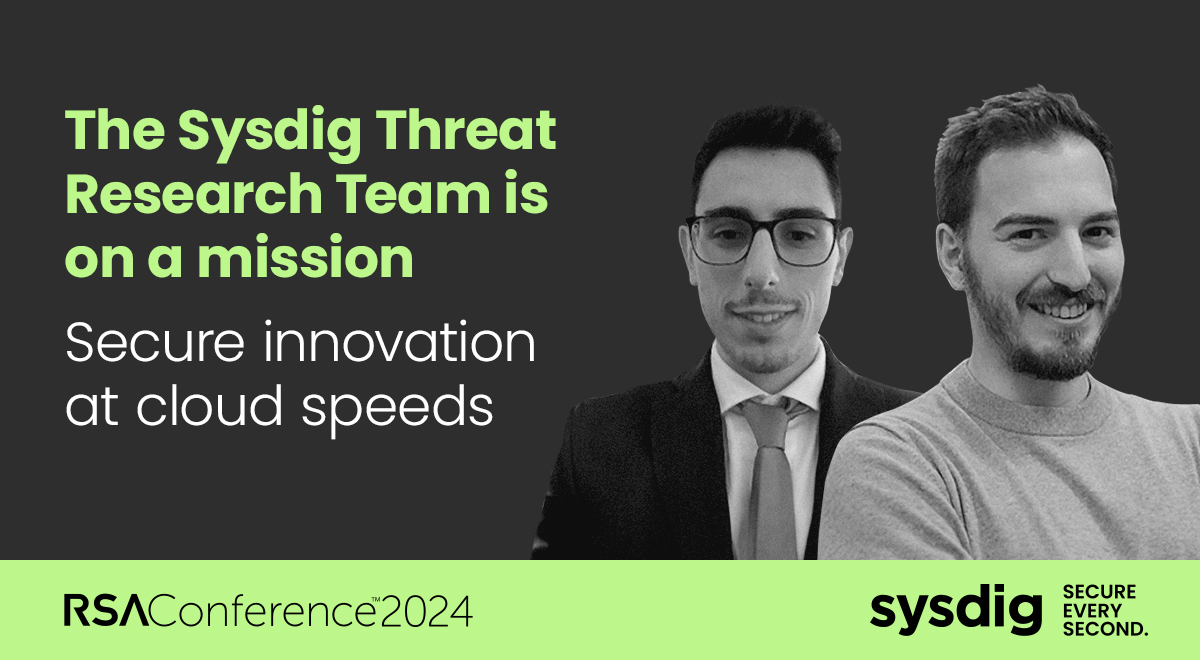
Falco Feeds extends the power of Falco by giving open source-focused companies access to expert-written rules that are continuously updated as new threats are discovered.

The Sysdig Threat Research Team (TRT) is on a mission to help secure innovation at cloud speeds.
A group of some of the industry's most elite threat researchers, the Sysdig TRT discovers and educates on the latest cloud-native security threats, vulnerabilities, and attack patterns.
We are fiercely passionate about security and committed to the cause. Stay up to date here on the latest insights, trends to monitor, and crucial best practices for securing your cloud-native environments. Or come meet us at RSA; we'll be at booth S-742.
Below we will detail the latest research that has been carried out and how we have improved the security ecosystem.
SSH-SNAKE
SSH-Snake is a self-modifying worm that leverages SSH credentials discovered on a compromised system to start spreading itself throughout the network. The worm automatically searches through known credential locations and shell history files to determine its next move. SSH-Snake is actively being used by threat actors in offensive operations.
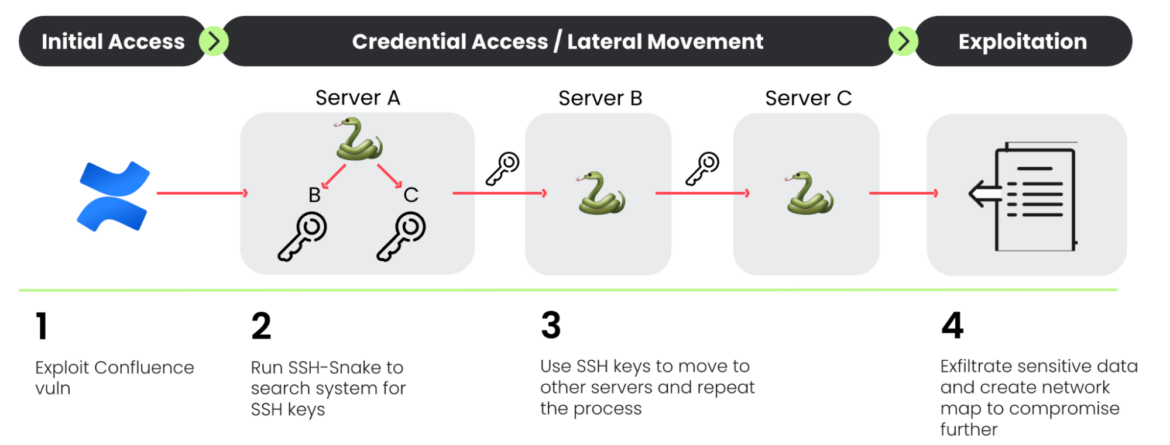
Sysdig TRT uncovered the command and control (C2) server of threat actors deploying SSH-Snake. This server holds a repository of files containing the output of SSH-Snake for each of the targets they have gained access to.
Filenames found on the C2 server contain IP addresses of victims, which allowed us to make a high confidence assessment that these threat actors are actively exploiting known Confluence vulnerabilities in order to gain initial access and deploy SSH-Snake. This does not preclude other exploits from being used, but many of the victims are running Confluence.
Output of SSH-Snake contains the credentials found, the IPs of the targets, and the bash history of the victims. We are witnessing the victim list growing, which means that this is an ongoing operation. At the time of writing, the number of victims is approximately 300.
RUBYCARP
Sysdig TRT discovered a long-running botnet operated by a Romanian threat actor group, which we are calling RUBYCARP. Evidence suggests that this threat actor has been active for at least 10 years. Its primary method of operation leverages a botnet deployed using a variety of public exploits and brute force attacks. This group communicates via public and private IRC networks, develops cyber weapons and targeting data, and uses its botnet for financial gain via cryptomining and phishing. This report explores how RUBYCARP operates and its motivations.
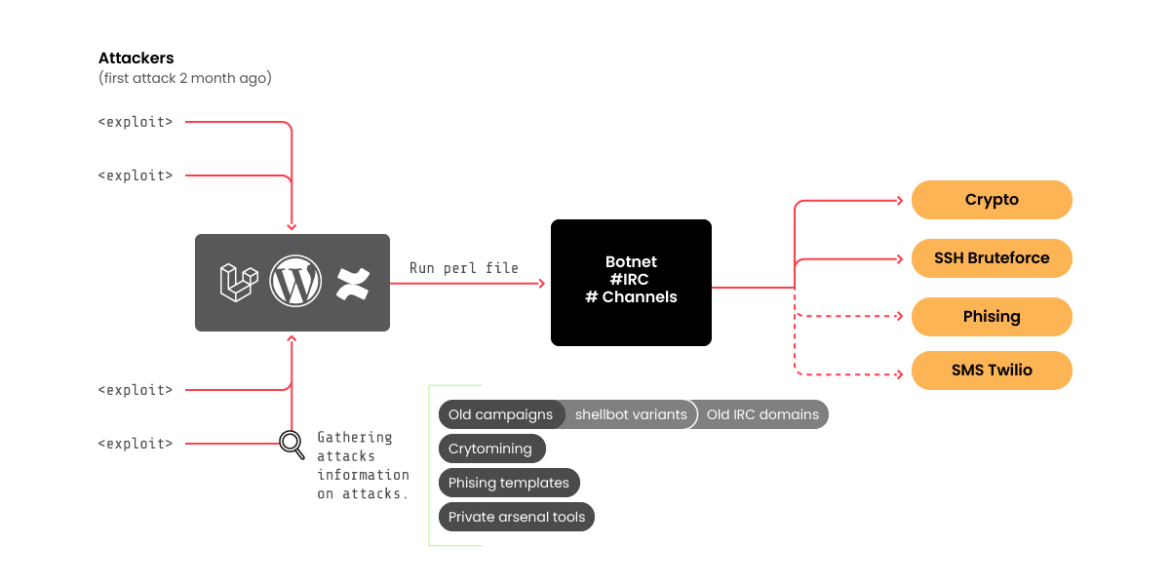
RUBYCARP, like many threat actors, is interested in payloads that enable financial gain. This includes cryptomining, DDoS, and Phishing. We have seen it deploy a number of different tools to monetize its compromised assets. For example, through its Phishing operations, RUBYCARP has been seen targeting credit cards.
SCARLETEEL
SCARLETEEL, a complex operation discovered in 2023, continues to thrive. Cloud environments are still their primary target, but the tools and techniques used have adapted to bypass new security measures, along with a more resilient and stealthy command and control architecture. AWS Fargate, a more sophisticated environment to breach, has also become a target as their new attack tools allow them to operate within that environment.
The attack graph discovered by this group is the following:
Compromise AWS accounts through exploiting vulnerable compute services, gain persistence, and attempt to make money using cryptominers. Had we not thwarted their attack, our conservative estimate is that their mining would have cost over $4,000 per day until stopped.
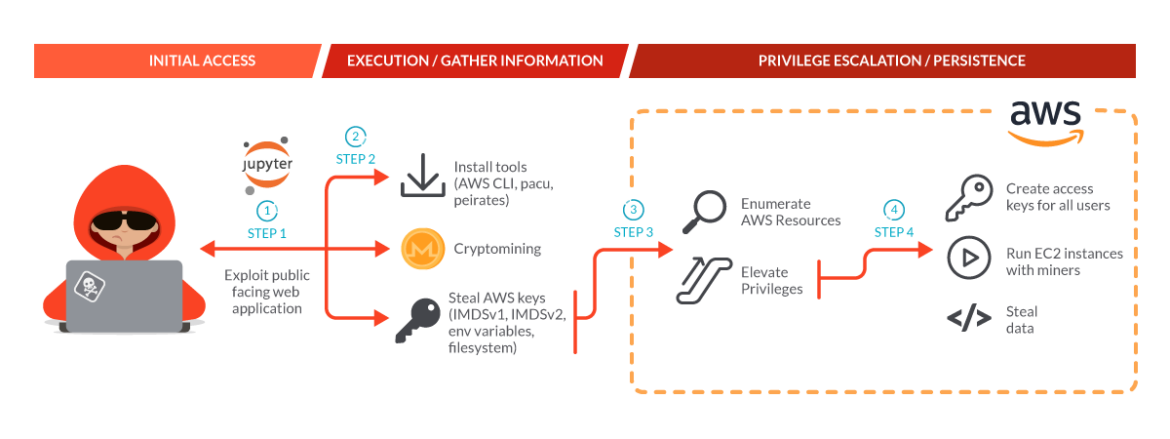
We know that they are not only after cryptomining, but stealing intellectual property as well. In their recent attack, the actor discovered and exploited a customer mistake in an AWS policy which allowed them to escalate privileges to AdministratorAccess and gain control over the account, enabling them to then do with it what they wanted. We also watched them target Kubernetes in order to significantly scale their attack.
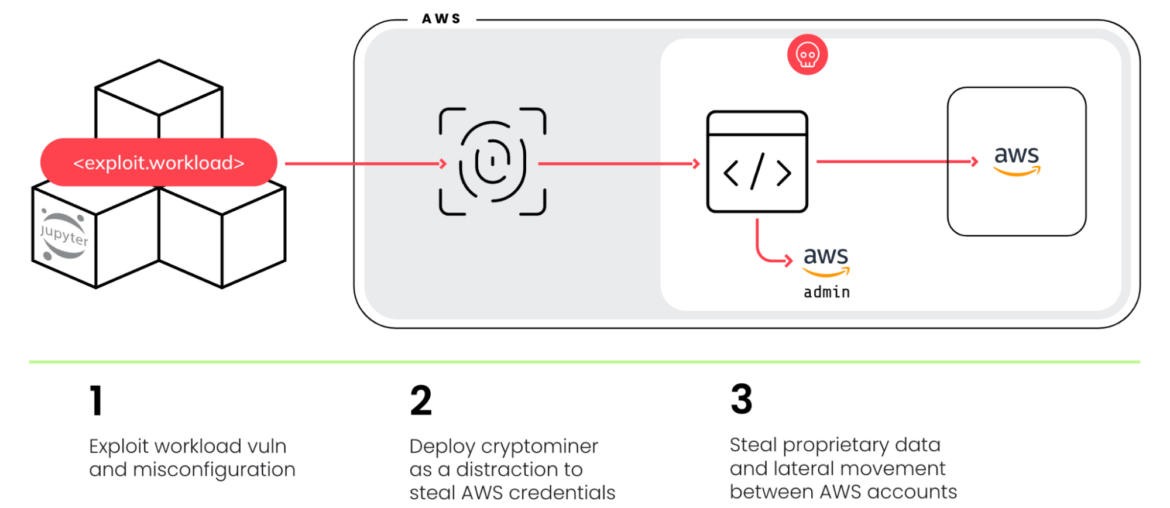
AMBERSQUID
Keeping with the cloud threats, The Sysdig TRT has uncovered a novel cloud-native cryptojacking operation which they've named AMBERSQUID. This operation leverages AWS services not commonly used by attackers, such as AWS Amplify, AWS Fargate, and Amazon SageMaker. The uncommon nature of these services means that they are often overlooked from a security perspective, and the AMBERSQUID operation can cost victims more than $10,000/day.

The AMBERSQUID operation was able to exploit cloud services without triggering the AWS requirement for approval of more resources, as would be the case if they only spammed EC2 instances. Targeting multiple services also poses additional challenges, like incident response, since it requires finding and killing all miners in each exploited service.
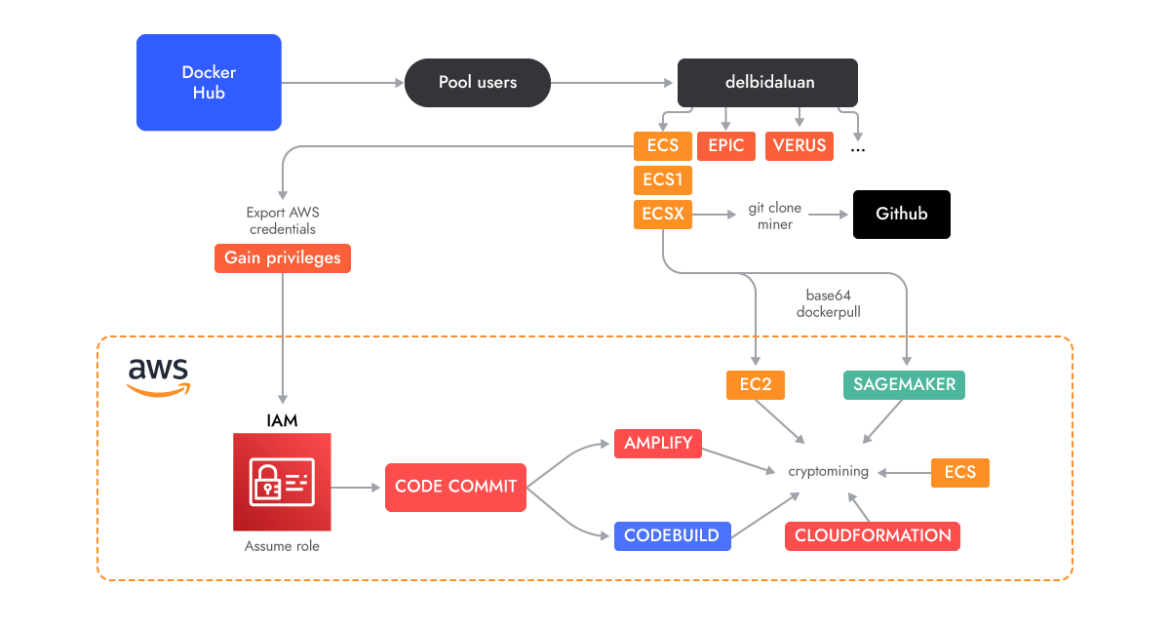
We discovered AMBERSQUID by performing an analysis of over 1.7M Linux images in order to understand what kind of malicious payloads are hiding in the containers images on Docker Hub.
This dangerous container image didn't raise any alarms during static scanning for known indicators or malicious binaries. It was only when the container was run that its cross-service cryptojacking activities became obvious. This is consistent with the findings of our 2023 Cloud Threat Report, in which we noted that 10% of malicious images are missed by static scanning alone.
MESON NETWORK
Sysdig TRT discovered a malicious campaign using the blockchain-based Meson service to reap rewards ahead of the crypto token unlock happening around March 15th 2024. Within minutes, the attacker attempted to create 6,000 Meson Network nodes using a compromised cloud account. The Meson Network is a decentralized content delivery network (CDN) that operates in Web3 by establishing a streamlined bandwidth marketplace through a blockchain protocol.

Within minutes, the attacker was able to spawn almost 6,000 instances inside the compromised account across multiple regions and execute the meson_cdn binary. This comes at a huge cost for the account owner. As a result of the attack, we estimate a cost of more than $2,000 per day for all the Meson network nodes created, even just using micro sizes. This isn't counting the potential costs for public IP addresses which could run as much as $22,000 a month for 6,000 nodes! Estimating the reward tokens amount and value the attacker could earn is difficult since those Meson tokens haven't had values set yet in the public market.
In the same way as in the case of Ambersquid, the image looks legitimate and safe from a static point of view, which involves analyzing its layers and vulnerabilities. However, during runtime execution, we monitored outbound network traffic and we spotted gaganode being executed and performing connections to malicious IPs.
LABRAT
The LABRAT operation set itself apart from others due to the attacker's emphasis on stealth and defense evasion in their attacks. It is common to see attackers utilize scripts as their malware because they are simpler to create. However, this attacker chose to use undetected compiled binaries, written in Go and .NET, which allowed the attacker to hide more effectively.
The attacker utilized undetected signature-based tools, sophisticated and stealthy cross-platform malware, command and control (C2) tools which bypassed firewalls, and kernel-based rootkits to hide their presence. To generate income, the attacker deployed both cryptomining and Russian-affiliated proxyjacking scripts. Furthermore, the attacker abused a legitimate service, TryCloudFlare, to obfuscate their C2 network.
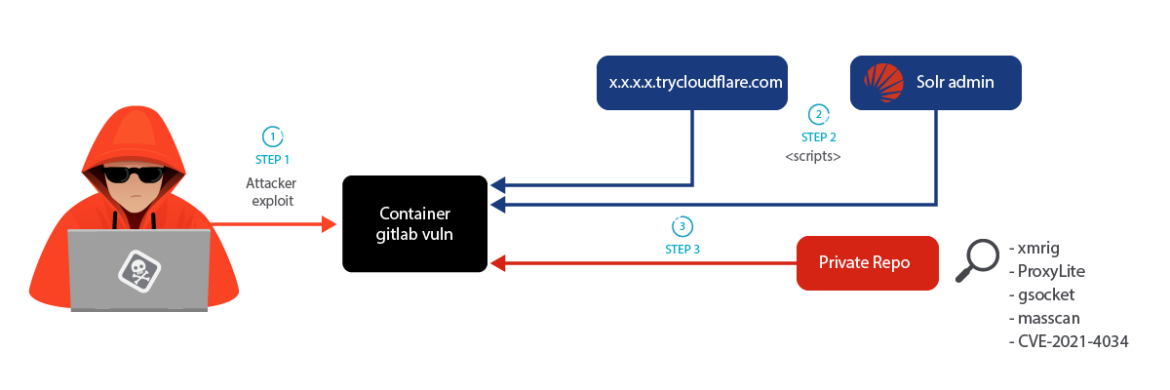
One obvious goal for this attacker was to generate income using proxyjacking and cryptomining. Proxyjacking allows the attacker to "rent" the compromised system out to a proxy network, basically selling the compromised IP Address. There is a definite cost in bandwidth, but also a potential cost in reputation if the compromised system is used in an attack or other illicit activities. Cryptomining can also incur significant financial damages if not stopped quickly. Income may not be the only goal of the LABRAT operation, as the malware also provided backdoor access to the compromised systems. This kind of access could lend itself to other attacks, such as data theft, leaks, or ransomware.
Detecting attacks that employ several layers of defense evasion, such as this one, can be challenging and requires a deep level of runtime visibility.
CVEs
The only purpose of STRT is not to hunt for new malicious actors, it is also to react quickly to new vulnerabilities that appear and to update the product with new rules for their detection in runtime. The last two examples are shown below.
CVE-2024-3094
On March 29th, 2024, a backdoor in a popular package called XZ Utils was announced on the Openwall mailing list. This utility includes a library called liblzma which is used by SSHD, a critical part of the Internet infrastructure used for remote access. When loaded, the CVE-2024-3094 affects the authentication of SSHD potentially allowing intruders access regardless of the method.
- Affected versions: 5.6.0, 5.6.1
- Affected Distributions: Fedora 41, Fedora Rawhide
For Sysdig Secure users, this rule is called "Backdoored library loaded into SSHD (CVE-2024-3094)" and can be found in the Sysdig Runtime Threat Detection policy.
- rule: Backdoored library loaded into SSHD (CVE-2024-3094)
desc: A version of the liblzma library was seen loading which was backdoored by a malicious user in order to bypass SSHD authentication.
condition: open_read and proc.name=sshd and (fd.name endswith "liblzma.so.5.6.0" or fd.name endswith "liblzma.so.5.6.1")
output: SSHD Loaded a vulnerable library (| file=%fd.name | proc.pname=%proc.pname gparent=%proc.aname[2] ggparent=%proc.aname[3] gggparent=%proc.aname[4] image=%container.image.repository | proc.cmdline=%proc.cmdline | container.name=%container.name | proc.cwd=%proc.cwd proc.pcmdline=%proc.pcmdline user.name=%user.name user.loginuid=%user.loginuid user.uid=%user.uid user.loginname=%user.loginname image=%container.image.repository | container.id=%container.id | container_name=%container.name| proc.cwd=%proc.cwd )
priority: WARNING
tags: [host,container]Leaky Vessels
On January 31st 2024, Snyk announced the discovery of four vulnerabilities in Kubernetes and Docker.
- CVE-2024-21626: CVSS – High, 8.6
- CVE-2024-23651: CVSS – High, 8.7
- CVE-2024-23652: CVSS – Critical, 10
- CVE-2024-23653: CVSS – Critical, 9.8
For Kubernetes, the vulnerabilities are specific to the runc CRI. Successful exploitation allows an attacker to escape the container and gain access to the host operating system. To exploit these vulnerabilities, an attacker will need to control the Dockerfile when the containers are built.
The following Falco rule will detect the affected container runtimes trying to change the directory to a proc file descriptor, which isn't normal activity. This rule should be considered experimental and can be used in OSS Falco and Sysdig Secure as a custom rule.
- rule: Suspicious Chdir Event Detected
desc: Detects a process changing a directory using a proc-based file descriptor.
condition: >
evt.type=chdir and evt.dir=< and evt.rawres=0 and evt.arg.path startswith "/proc/self/fd/"
output: >
Suspicious Chdir event detected, executed by process %proc.name with cmdline %proc.cmdline under user %user.name (details=%evt.args proc.cmdline=%proc.cmdline evt.type=%evt.type evt.res=%evt.res fd=%evt.arg.fd nstype=%evt.arg.nstype proc.pid=%proc.pid proc.cwd=%proc.cwd proc.pname=%proc.pname proc.ppid=%proc.ppid proc.pcmdline=%proc.pcmdline proc.sid=%proc.sid proc.exepath=%proc.exepath user.name=%user.name user.loginuid=%user.loginuid user.uid=%user.uid user.loginname=%user.loginname group.gid=%group.gid group.name=%group.name container.id=%container.id container_name=%container.name image=%container.image.repository:%container.image.tag)
priority: WARNING
tags: [host, container]MEET SYSDIG TRT AT RSAC 2024
Sysdig Threat Research Team (TRT) members will be onsite at booth S-742 at RSA Conference 2024, May 6 – 9 in San Francisco, to share insights from their findings and analysis of some of the hottest and most important cybersecurity topics this year.


